Mark Sisson's Blog, page 361
October 12, 2012
We Are Talking About a Drastic Increase in Quality of Life!
It’s Friday, everyone! And that means another Primal Blueprint Real Life Story from a Mark’s Daily Apple reader. If you have your own success story and would like to share it with me and the Mark’s Daily Apple community please contact me here. I’ll continue to publish these each Friday as long as they keep coming in. Thank you for reading!
 Thanks to MDA, my husband Jesse and I are reformed from our carboholic ways. To give you an idea of the magnitude of our addiction to carbs, this is what would happen during our normal weekly grocery shopping trip: We would hit the bakery section first. They had those huge fluffy loaves of French bread. Warm. We would get two. We would tear off chunks of the bread and eat a whole loaf as we walked through the grocery store. The other one, we would turn into garlic bread to go with our spaghetti for dinner that night. And that was after having a whole grain English muffin or oatmeal for breakfast (because at least the whole grains and oats were good for you, right??)
Thanks to MDA, my husband Jesse and I are reformed from our carboholic ways. To give you an idea of the magnitude of our addiction to carbs, this is what would happen during our normal weekly grocery shopping trip: We would hit the bakery section first. They had those huge fluffy loaves of French bread. Warm. We would get two. We would tear off chunks of the bread and eat a whole loaf as we walked through the grocery store. The other one, we would turn into garlic bread to go with our spaghetti for dinner that night. And that was after having a whole grain English muffin or oatmeal for breakfast (because at least the whole grains and oats were good for you, right??)
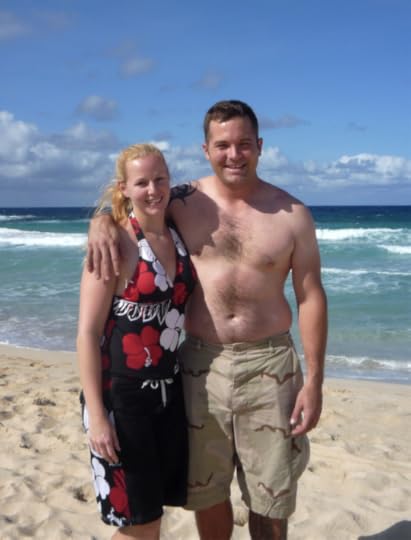
Other than our diet, we were pretty healthy. I lifted weights 7 days a week; for Jesse, 2-4 days a week of weight lifting and cardio. Living in Hawaii, Play was super easy – we would climb a mountain or go spearfishing on the weekends. (Side note: catching your own dinner is extremely satisfying!) We got plenty of sleep. But I was still never able to get below a size 9, no matter how much I worked out. Jesse had a 38 inch waist. It never dawned on us that maybe we should change what we were eating!

Jesse came across your website in July 2011, and suggested that we give the diet a try. I told him he was crazy – grains were half of my diet and there was no way I could give them up! He was smart enough to show me a picture of Carrie Sisson, and I realized that she looked way better than me. Working out 7 days a week I wasn’t even coming close to looking as good as her, so I was willing to give it a try. Jesse quit grains and sugar cold turkey, I limited myself to one processed food item a day for the next 3 weeks. He got the low carb flu, I did not.
We were amazed at the results! We were sleeping better at night and had much more energy during the day. My face cleared up. My one irritable day a month disappeared, and took my cramps with it. My rosacea vanished. Doctors had put me on six different prescriptions for it, and nothing had ever helped. With rosacea, you can’t even take a hot shower or get too hot when you are working out without your face turning bright red and staying that way for an hour. I’m happy to say I can now take a hot shower and workout as intense as I would like without any adverse effects to my face. These aren’t just minor improvements, we are talking about a drastic increase in quality of life!

Three weeks after we started the diet, Jesse’s term was up with the Navy and we moved to South Carolina. Starting with an empty pantry, it was easy to Primalize it. By October, we looked great! Jesse had dropped four inches to a 34-inch waist, and I was down from a size 9 to a size 5. We have worked very hard to make sure that we are eating quality foods and sticking with the Primal guidelines. We had no problem buying healthy foods, our only weakness was eating with others. It took many months, but we can now finally turn people down when we are at their homes and they push a platter of brownies towards us.
In the past few months, our weight started to creep back up. It wasn’t until I read your posts about the 21-Day Challenge that I realized why – we were doing great with the diet, but we were neglecting many of the other aspects of being Primal! We didn’t find it as easy to Play here – it is flat and the water is cloudy, so our favorite activities are out and we hadn’t really tried to find anything to replace those activities. Working out had definitely slid to the back burner without us realizing it.
It would be super easy to make excuses. I get up at 4:30 am and don’t return home until 6 pm (and not until after 10 pm on Mondays and Thursdays). It doesn’t leave much time for working out and getting enough sleep. But, instead of making excuses I decided to figure out how I could incorporate working out into my day. Now I do squats and calf raises as I brush my teeth in the morning and evening. I get into what Tony Horton calls horse stance (legs out to the sides, knees bent, thighs almost parallel to the ground), up on my toes, while I do my face and hair. I do a set of pushups off the side of the bathtub before I get in the shower. Our home is long and has a straight shot from the office, through the living room and dining room, into the kitchen. Now I run as fast as I can when passing through these areas. These mini sprints get my heart rate up. When taking a break at work, I walk around the outside of the building and jog up the stairs. I put my dumbbells on the living room floor to remind myself to stop and lift them throughout the time I am at home. I’ve started taking quick naps some days after work and longer naps on the weekends.
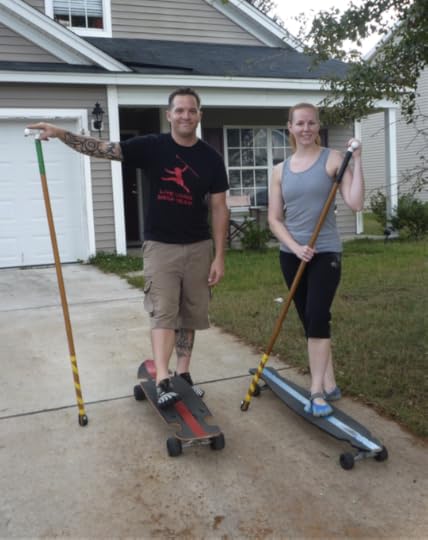
For Play, we go stand up paddle skateboarding. (Kind of like SUP, just on land. It’s a great upper body workout!) Jesse uses Ultimate Frisbee as well for his Play. He has made a renewed commitment to working out 3 days a week when he gets home from work, and I have committed to at least one real work out session on the weekend. Jesse even created some pieces of equipment for us to work out with at home: a balance board to make squats and dumbbell work harder. A 5 gallon jug filled with water, with a straight bar through the handle, to use for curls and rows. A PVC pipe filled with sand, with old rotors on the end, to use as a barbell. Three different size tires to lift and throw. A sturdy wood box for jump training. An incline made out of wood (functions like an incline bench, just with your behind on the ground). And 30-40 pound rocks to do curls with and to throw.
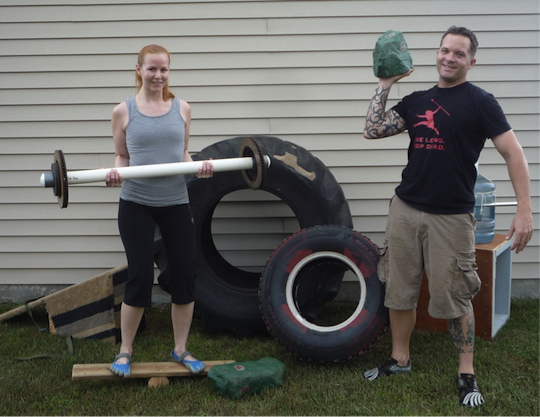
We are definitely excited that you have once again helped to spark a commitment in us to be healthier, and to realize what we were lacking. While we know we won’t be ripped in just 21 days, we can’t wait to see the long term results! In less than 2 weeks I’m already down 3 pounds of fat and Jesse’s clothes are fitting him much better now. Thank you for everything that you do to inspire all of us!
Jesse and Vicki
Grab The Primal Blueprint Cookbook Today and Receive Free S&H and a Free Primal Blueprint Poster

October 11, 2012
Fall Foods: Why Seasonal Eating Primes the Body for Fat Burning
 This is a guest post from Mira and Jayson Calton of Calton Nutrition. As many of you know, I’ve written extensively on the seasonality of eating, and the fractal nature of early human existence. In this guest post, the Caltons share a few of their own insights and discoveries on seasonal eating patterns, and provide a new perspective on weight loss plateaus. Enter the Caltons…
This is a guest post from Mira and Jayson Calton of Calton Nutrition. As many of you know, I’ve written extensively on the seasonality of eating, and the fractal nature of early human existence. In this guest post, the Caltons share a few of their own insights and discoveries on seasonal eating patterns, and provide a new perspective on weight loss plateaus. Enter the Caltons…
“Whoever wishes to investigate medicine properly should proceed thus: in the first place to consider the seasons of the year.”
- Hippocrates, the father of medicine (circa 400 B.C.)
Even for those of us living in Florida, the unexpected crispness in the morning air is a sure sign that summer is over. And, just as the seasons change, so do the foods mother earth brings forth. Like winter, spring and summer before it, fall brings with it a unique bounty of colorful and delicious seasonal produce. It might surprise you to learn that the term “fall” is actually quite new. Prior to the 16th century, this season was known as “harvest.” In fact, both the Dutch and German words for this season are still based on the seasonal reaping of the crops. However, in many other languages, including English, by the 1500s the term harvest had lost any real relevance for most people. As industrialization took hold, more and more families moved into the cities, leaving farming behind. As the masses of urban city dwellers grew, this season’s name was changed from “harvest” to “fall” – a word adopted from the Old Norse word used to express “a falling from a height” like that of the leaves from the trees.
In modern times, the fall season conjures up images of Halloween, Thanksgiving, warm fires and hearty meals – things that can easily cause you to fall off your normal dietary pattern and put on a few pounds. In fact, starting in the fall and usually ending January 1st (think New Year’s resolution), millions around the world suffer through the annual tradition of weight gain. This seemingly unstoppable event leaves most frustrated and angry with themselves for once again falling off their diets and regaining either a portion or all of the weight they worked so hard to lose. But here is where this story gets interesting. While it is true from one perspective that this seasonal weight gain may look like an unwanted setback, what if, from another perspective, it was a natural and beneficial way to reset and prime your metabolism for efficient and sustained fat burning?
Do we have your attention? During the Calton Project (our 6-year, 100-country, 7-continent global expedition to observe the lifestyle and dietary habits of remote, semi-remote and urban people throughout the world to discover how different nutritional philosophies affected overall health), we made several interesting observations. The first was that micronutrient deficiency is the most widespread and dangerous health condition of the 21st century – but that is a topic for a different blog. (Read our first book, Naked Calories, to find out more.)
The second and equally important observation was that the groups exhibiting the most impressive physiques and vibrant health did not voluntarily restrict available foods from their dietary profiles – meaning they did not choose their food based on whether it was low fat, low carb, animal or plant-based. Instead, they ate what was available to them at any given time. In short, they ate seasonally. We have come to believe that seasonal eating contains a certain innate wisdom that communicates biochemically with the body, which efficiently and effortlessly signals it to burn fat, gain muscle, maintain weight and, yes, even gain fat. While the foods of each season bring within them unique communications that over millennia have helped mankind survive, in this blog we will focus on what the fall foods are telling your body to do.
So what are “fall foods” and what are they signaling your body to do? Depending on your geographical location, fall foods differ; but generally speaking, in America when we think of fall we think of foods like potatoes, corn, apples, pumpkins, dates, figs, pears and squash. Thoughts of Thanksgiving, the harvest, and cornucopias filled with colorful produce come to mind. Yes, there is still turkey, duck, venison, fish and all the wonderful meats we cherish and enjoy year round, but the key to understanding fall’s signal is in that first group of foods. What is the big difference between turkey, duck and venison and foods such as potatoes, corn and apples?
The first group is comprised primarily of protein and fat, whereas the second group is composed primarily of carbohydrates. Each of the three macronutrients (protein, fats, carbs) give off a unique signal to the body and that signal changes quite dramatically when macronutrients are combined. This means that while fat and protein may give off one signal, protein and carbohydrates give off a completely different one. It’s like a code; the foods inherent to each season are made up of a basic macronutrient ratio – as the seasons change, so do the foods, the macronutrient ratio, and the signal telling your body what to do. Are you starting to see where we are going here?
Okay, we have probably said WAYYYYY too much already. Our third book, which will reveal our 4SEASONSFORLIFE® Revolutionary Lifestyle program and will be published by Primal Blueprint Publishing, won’t come out till next year and Mark doesn’t want us to spoil the surprise. Besides, Primal Blueprint Publishing still has our second book, Rich Food, Poor Food – Your Grocery Purchasing System (GPS) to release first in February. However, he did say we could release this sneak peak and talk about how fall foods affect health. So, let’s get back on track.
In the fall, nature provides a diet comprised of all three macronutrients: fat, protein and carbohydrates, but these aren’t just any carbohydrates. Fall brings forth very specific kinds of carbohydrates – starchy carbohydrates and high sugar fruits – foods designed to give you lots of energy and cause an addictive response.
Think of it this way: You live in what is now Minnesota 100,000 years ago, and one fall day you see a big red thing on the tree (apple). You pick big red thing off tree and eat it. You like big red thing. You shake tree and many big red things fall. You pick up as many big red things as you can carry and take them back to your tribe. Everyone loves big red things and they eat them until their hearts are content. The next day everyone wakes up and wants more big red things and you notice more trees with more big red things on them. You don’t need to hunt since there are so many big red things everywhere that taste so good. The weather is cool, the days are shorter, you eat, you sleep, you gain a layer of fat – just in time for winter.
Now we’ve obviously simplified this story, but did you see how everything worked together perfectly to effortlessly and efficiently get the tribe fattened up and ready for a cold, long winter? No special training was needed. Nature, in its infinite wisdom, simply enveloped us in an environment that used color to attract us to particular foods, pleased us with flavor and addicted us to a food type that when eaten in great enough quantities would stimulate a fat storage hormone. This hormone would eventually produce a layer of stored energy that would insulate us from cold weather and would be used as an energy source during the dormant months of winter. In addition, the days are shorter in the fall, which is nature’s way of further restricting overall energy expenditure and promoting weight gain.
If you don’t think this is a big deal, imagine the story again; but this time when you take as many big red things as you can back to your tribe, everyone eats big red things and loves big red things – except Eve, who hates big red things. The next day everyone except Eve wakes up and wants more big red things and so while the rest of the tribe is unknowingly preparing themselves for winter survival, Eve, due to that fact that she did not become addicted to the big red things, is not storing fat and is not preparing herself for winter survival. When winter comes and everyone else is able to maintain proper body temperature and has stored fat to use as fuel, Eve is cold, weak and has an increased risk of sickness, and death. (We hope you didn’t have your eye on that one as a possible mate.)
Our point is that although as a culture we have devised ways to stay warm and have the luxury of an unlimited variety of foods available year round, our bodies still react with the age-old evolutionary methods for preservation. That is to say, weight gain in the fall has always been normal and essential throughout the history of mankind. While our modern day environment is far from that of our ancestors, our attraction to brightly colored foods and our addiction to carbohydrates (sugar) is still very much intact.
You’re probably wondering when we are going to get to the part about how gaining fat can help to burn fat. Well, we’re here. When you look at everything we just discussed you can see how a constant state of weight loss would not have been a very natural or beneficial state for overall survival. The modern “get thin at any price” mentality has led most of us to believe that weight loss equals “good” and weight gain equals “bad.” However, what if weight gain was simply the evolutionary signal that resets and primes your metabolism for efficient weight loss and fat burning?
Regardless of the diet attempted, we have all experienced a frustrating period of plateau – when the weight loss stalls and there seems to be nothing we can do to kick-start it. Instead of struggling at this point and falling victim to the “eat less and exercise more” mantra that inevitably ends in disaster, what if we tried something completely different – an eat more, exercise less philosophy? Crazy, right? But what if a weight gain period, even a small one, signals something deep in our DNA that primes the body for fat burning? Isn’t that what the fall season did for our ancestors for eons? As said before, we don’t want to say too much so we will end the blog here. But before we go, we want to urge you to think about what we have said.
In our modern world of clinical trials and cutting-edge techniques we can sometimes lose sight of the more natural, less complicated methods for achieving our goals. While endless hours of cardio and bird-sized rations may look on paper like it will equate to the weight loss you so desperately seek, this equation over time eventually leads to micronutrient deficiencies, frustration, injury and failure. Perhaps a seasonal prescription is a better way to go. Think of it as a carb re-feed carried through to its natural end. Just as fat was vilified for so many years by those who didn’t, and still don’t, understand it, we urge you to see a small weight gain period not as something bad, but as something beneficial – a clever code written by nature herself, that once deciphered can aid you in achieving optimal health and living your optimal life!
Learn More About the Caltons at Calton Nutrition and Stay Tuned for Their Upcoming Books

October 10, 2012
Why You Shouldn’t Burn More Than 4,000 Calories a Week Through Exercise
 Everyone agrees that being sedentary is bad and unhealthy and that being active is good and healthy. The research agrees, too; regular physical activity leads to good health, longer lives, and an improved ability to function throughout normal life. When you’re able to walk to the store, carry your groceries home, take the stairs, get out of bed without struggling, pack enough lean mass to survive a stay in the hospital, and ride your bike when you want to, you’re a functional human being, and remaining active on a regular basis helps maintain this state so crucial to basic health and happiness.
Everyone agrees that being sedentary is bad and unhealthy and that being active is good and healthy. The research agrees, too; regular physical activity leads to good health, longer lives, and an improved ability to function throughout normal life. When you’re able to walk to the store, carry your groceries home, take the stairs, get out of bed without struggling, pack enough lean mass to survive a stay in the hospital, and ride your bike when you want to, you’re a functional human being, and remaining active on a regular basis helps maintain this state so crucial to basic health and happiness.
But what’s often hidden amidst the blanket pro-exercise sentiment is that too much exercise can have the opposite effect on health – people can really take physical activity too far. I talk about this all the time, so much that you’ve probably got “Chronic Cardio” emblazoned across your brain and shake your head when you see some hapless soul in spandex and the latest runners heaving himself down the street, heel first. I know just how bad that stuff can be, because I did it for a large part of my life. You’ve all heard that story before, though, about how even though training cardio hard gets you “fitter” in one sense of the word, it’s actually counterproductive for a healthy long life (doubly so if you want to have some lean muscle mass and pain-free joints in your later years).
We’ve seen hints in studies over the years:
One recent study found that in overweight sedentary subjects, moderate exercise was more efficient at helping them burn body fat – including a reduction that was far greater than what could be explained by the caloric expenditure – while intense exercise induced a “compensatory” response that hampered fat loss.
Another study examined weekly caloric expenditure via aerobic exercise in a group of former athletes and non-athletes and plotted it against mortality, cardiovascular disease, and hypertension. Death rate was highest in groups 1 and 2, the ones with the least amount of caloric expenditure, but group 6 (along with 1), which expended 2,500+ calories per week, had the highest rates of heart disease and high blood pressure. Those who exercised moderately lived the longest and were healthiest.
In a study on the exercise habits of college alumni and their impact on mortality, researchers found that up to 3,500 calories expended per week conferred a survival benefit, but at calorie expenditures greater than that, mortality began to tick upwards.
And in a pair of recent studies, researchers found that moderate exercise – jogging up to 20 miles a week at an 11 minute mile pace – offered the most protection against early mortality. Running more than 20 miles a week, or running at a 7 minute mile pace, offered fewer mortality benefits. In the second paper, Danish scientists found that people who spent one to two and a half hours jogging at a “slow or average pace” lived longer than those who didn’t run at all or who ran at a faster pace. James O’Keefe, a cardiologist and presenter at the Ancestral Health Symposium, was quoted as saying that “after about 45 to 60 minutes a day, you reach a point of diminishing returns.”
It’s pretty clear that once exercise gets to be “too much,” the benefits are reduced, or even reversed, and it becomes a chronic stressor that reduces overall wellness.
And so I thought it’d be helpful to give you guys a guideline for determining just how much is too much. This is a guideline I’ve had great success with, whether I’m training myself or clients: no more than 4,000 calories expended through focused exercise per week.
Is this a hard and fast rule? No, not exactly. Going somewhat above is probably okay.
Is it concretely established in numerous studies? There are hints toward its veracity in the literature, but nothing explicit. This is mostly stuff gleaned through experience (but the research does bear it out).
Does it apply to everyone, everywhere, whatever their goals may be? No. Someone training for the Hawaii Ironman Triathlon is going to require more if they hope to compete.
But as a general rule for the general population, it really does work well as a guideline. Burning 4,000 calories through focused exercise appears to be the cut off point (yeah, you could go a bit under or over, but the point is that we need to draw the line somewhere) after which health – including immune function and oxidative stress load – and quality of life – including free time, energy levels, and productivity – begin to take hits. Your performance may increase, and this might be worth it to you if your goals are primarily performance-oriented, but there’s a trade off. Keith Norris often writes about this idea, calling it the health-performance curve. I’m inclined to agree with him.
So – what does 4,000 calories worth of expenditure in a week look like, exactly?
Well, the simplest way I’ve found to describe it is in terms of road miles. If you’re doing 40 miles a week running or 80 miles a week cycling, you’re hitting roughly 4,000 calories. We don’t just run or bike, of course. We lift weights, we circuit train, we engage in metabolic conditioning, we row, we wrestle, we hike, we sprint, we box, we swim.
You could use an online calculator like FitDay or ExRx to get a better idea. For a 185 pound, 6 foot tall person to burn just around 4,000 calories a week, he could get away with:
Running six miles.
Lifting weights intensely for two hours total.
Biking 13 miles.
Playing an hour and a half of field sports (soccer, rugby, football, Ultimate).
That’s a pretty solid week of activity, I’d say, but it certainly isn’t excessive, and it would provide a far more well-rounded sense of fitness than just pounding away at the road for 40 miles. Feel free to use the (admittedly imperfect) tools linked above to figure out what your regular caloric expenditure looks like.
Not all activity “counts” toward your caloric expenditure. Taking a 30-minute stroll to the store doesn’t count as focused work. Taking a 60-minute hike up in the hills does. Going for a nice relaxing ride on the bike around the neighborhood doesn’t count, but doing twenty miles in a single day does. Carrying the groceries from the car to the house doesn’t count; carrying the groceries from the store to the house just might, though. “You know it when you see it” applies here, so use your better judgment.
I’d also suggest that expending your calories through a variety of activities is “better” than expending them through a single activity. As shown above, lifting weights, going for a run, biking a bit, and playing sports is more fun and probably less stressful than expending all your calories through running, which is veering into Chronic Cardio territory. A calorie (expended) is not a calorie (expended).
Look – exercise as often and as intensely as it pleases you. Just be aware that, in my opinion (having looked at the literature and drawn from my own experience training myself and others), 4,000 calories of focused work per week is the cut off point after which health and happiness begin to suffer for most people. If you’re an athlete whose only job is to train, and you’re privy to massages and cutting edge recovery techniques and everything else, then you’ll be able to handle more work. You’ll be far fitter than the average person and thus better equipped to mitigate the oxidative fallout from excessive exercise. But for members of the general population who have to contend with the day-to-day stress of living in this world, getting up early to feed the kids and beat traffic, balancing exercise time with work time with family time with personal time, sneaking peeks at the latest blog post, hoping to get enough sleep to make it through the next day? You’re going to have a harder time recovering from the stress of a 4,000+ caloric expenditure to make it worth your while.
That’s it for today, folks. Let me hear what you have to say about this 4,000 calories a week guideline. Do you agree? Disagree? Wholeheartedly forsake everything that I henceforth write? Let me hear all about it!
Grab The Primal Blueprint Cookbook Today and Receive Free S&H and a Free Primal Blueprint Poster

October 9, 2012
Is Organic a Scam? – Nutrient Differences
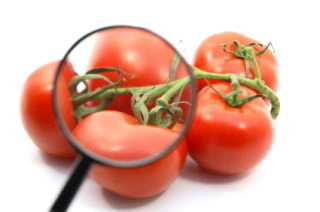 Even if you can get folks to begrudgingly admit that organic foods tends to contain fewer pesticide residues than conventional (and that this might even impact a person’s health or the way a child develops), they’ll dig in their heels when it comes to the nutritional content. And why shouldn’t they? Organic isn’t really about getting more vitamins, minerals, or other nutrients; it’s always been about getting vitamins, minerals, and other nutrients without the conventional pesticides, herbicides, and fungicides that so often accompany conventional produce. The presupposition that proponents of organic produce claim it contains more nutrients is a bit of a straw man, as that claim is rarely – if ever – made.
Even if you can get folks to begrudgingly admit that organic foods tends to contain fewer pesticide residues than conventional (and that this might even impact a person’s health or the way a child develops), they’ll dig in their heels when it comes to the nutritional content. And why shouldn’t they? Organic isn’t really about getting more vitamins, minerals, or other nutrients; it’s always been about getting vitamins, minerals, and other nutrients without the conventional pesticides, herbicides, and fungicides that so often accompany conventional produce. The presupposition that proponents of organic produce claim it contains more nutrients is a bit of a straw man, as that claim is rarely – if ever – made.
But what if that mythological claim actually held a kernel of truth? I mean, now that they’ve mentioned it and let that monkey out of its cage, let’s explore a bit to find out, starting with the Stanford study that sparked this whole topic.
If you take the Stanford meta-analysis at its word, you’ll conclude that “published literature lacks strong evidence that organic foods are significantly more nutritious than conventional foods.” Yet critics of the study argue that mistakes were made and that certain nutrients were overlooked, or undervalued, by the authors. One such critic, Dr. Kirsten Brandt, an agricultural scientist who specializes in how growing conditions impact the nutritional density and composition of produce, conducted a similar meta-analysis of the literature that covered much of the same literature as the Stanford study and came to a slightly different conclusion.
Brandt’s review covered more nutrients than the Stanford review. She found it puzzling that the Stanford researchers chose to “include [nutrients] where the difference was smallest to begin with” while omitting others “that were just as well-described in the papers they included.” They also wrote that there was no difference in total flavanol content, which directly contradicted Brandt’s findings, but a closer look showed that they’d merely misspelled flavonol – an honest mistake, albeit one that cloaked a major benefit of organic produce.
Contrary to the recent paper, Brandt’s analysis found that organic produce tended to provide significantly more vitamin C and “secondary metabolites.” Secondary metabolites, or bioactive compounds that aren’t directly involved in the plant’s growth, maturation, or reproduction, include the antioxidant compounds – the polyphenols, the flavonoids, and all the other phytonutrients - that make fruits and vegetables so uniquely healthful and which the evidence suggests is the primary explanation for the association of produce consumption with increased health. Although these secondary metabolites provide health benefits to those who eat them, for the plants, they are self-defense mechanisms. And without copious amounts of conventional agricultural chemicals doing the protecting, plants grown organically must manufacture more of their own protective compounds to stay alive, particularly if they’re subjected to stressors (like physical trauma, at least in the case of sweet potatoes). This is good for us. It’s as if growing plants organically trains them to be better and more beneficial.
Other papers suggest nutritional differences as well, also primarily in terms of secondary metabolites and other “minor” antioxidant compounds:
A 2010 study examining the fruit quality of three varieties of organic and conventional strawberries found some pretty important differences. First, organic strawberries tended to win the blind taste tests. They were smaller, but denser. They were brighter, which correlated with increased levels of phenolic compounds and other antioxidants. Organic strawberries also had more vitamin C, lasted longer on the shelf, and were more resistant to fungus (despite having no anti-fungals applied).
Another review (PDF) found that, by and large, organic produce had greater levels of secondary metabolities and tended toward more magnesium, vitamin C, iron, and phosphorus. Interestingly, the author also found that differences existed between newly-organic farms and more “mature” organic farms; the longer soil was worked using organic methods, the more nutrient-rich its produce. Thus, it’s possible that many of the studies showing little to no difference between conventional and organic were using “young” organic farms that had yet to reach their potential.
Most of these secondary metabolites aren’t going to show up in a nutritional database. They won’t help you pad your MyFitnessPal stats. They aren’t “essential” to health like vitamin D, vitamin C, or protein are and thus won’t register as very important in most meta-analyses, but they certainly make life a whole lot better (and longer, and healthier, and possibly even less cancer-y).
What about minerals?
Seeing as how the mineral content of produce depends on the mineral content of the soil in which the produce was grown, most studies find little difference between the mineral content of organic and conventional stuff. The biggest general determinant of mineral density in food appears to be geographical location, since different regions have different soil compositions. Even members of the same vegetable variety from different areas of the country can have wildly different levels of certain minerals depending on the mineral level of the soil. That said, one study found that organic crops had higher levels of magnesium, iron, vitamin C, and phosphorus, with lower levels of nitrates. It’s not that getting ordained by the organic gods magically increases the amount of magnesium in your soil; if organic chard has more magnesium, it may be that the organic chard farmer was just really dedicated to soil maintenance. From talking to the farmers at the farmers markets, I get the sense that this is probably the case.
My personal hunch? The food I buy from the farmers market from people with dirt under their fingernails is more nutritious than the food I get from the grocery store. It certainly tastes better. The odd-looking winter squash with orange knobby protrusions that the farmer says tastes like a cross between kabocha and butternut, or the pale butternut squash from Trader Joe’s? The dry-farmed early girl tomato that weighs twice as much as the same-sized store-bought conventional tomato? The room temp broccoli that’s never seen a fridge before laid out in the Santa Monica sunshine, or the bushel of Costco broccoli florets languishing in the industrial refrigerator? All that flavor, that weight, and that density can’t just be handwaved away as ephemera without a nutritional corollary. Nutrients – no matter how micro they are – occupy physical space. They have mass. If this tomato weighs a quarter pound more than that tomato, there is something qualitatively different about it, and it’s probably got something to do with the nutritional content (with it, ya know, being food and all).
Plus, the “organic” produce I get – whether it’s unofficial organic or proudly displays the emblazonment for all to see – tastes better to me and my family. The strawberries are firmer, sweeter, and more tart; if it’s the increased vitamin C content coupled with more robust intracellular plant matrices (yep, made that up), I don’t really care. The kale’s more bitter and pleasantly pungent; if that’s the increased polyphenol content, good for it. I like the taste. The increased micronutrient density (if it exists, and it looks like it probably does) is just a welcome addition.
Still, the research appears to say that, contrary to what the latest study would have you believe, organic produce tends to be more nutritious, particularly if you count something like a plant pigment with antioxidant qualities or a flavonoid as a “nutrient.” I definitely do, but I can see why someone who lives and dies by a standard nutritional database would overlook them. Vitamins and minerals are vital and all, but they aren’t everything.
What do you think, folks? I realize that you’ve probably never ordered micronutrient testing for your organic baby bok choy and compared it to the stuff from the supermarket, but have you noticed any qualitative differences between produce from different sources? What about that most important of qualities – taste? Let me and everyone know in the comment section!
Thanks for reading.
Grab The Primal Blueprint Cookbook Today and Receive Free S&H and a Free Primal Blueprint Poster

October 8, 2012
Dear Mark: Managing a Cheat Day and “Raw” Almonds
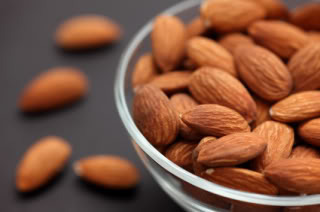 We’re finally back in the swing of things. Back to the regular programming. It’s good to shake things up now and then, but there’s really nothing quite like getting back into your normal groove. Last week, I published a Dear Mark on a Tuesday, and it honestly sort of threw me off for the rest of the week. Creature of habit, what can I say.
We’re finally back in the swing of things. Back to the regular programming. It’s good to shake things up now and then, but there’s really nothing quite like getting back into your normal groove. Last week, I published a Dear Mark on a Tuesday, and it honestly sort of threw me off for the rest of the week. Creature of habit, what can I say.
Speaking of shaking things up, the first of today’s two questions concerns shaking things up with a total binge day – a cheat day wherein you eat all the stuff you haven’t been eating for months, or even years. When that happens, what do you do? How do you prepare? How do you handle the aftermath? I’ll give my advice in the response. And then I talk about “raw” almonds, or almonds that have actually been pasteurized but still get called “raw.” I include a little almond history (all completely true and verifiable by primary sources, of course) as well as my take on “raw” almonds.
Let’s go:

Dear Mark,
Do you have any suggestions for how a (mostly) Primal person can manage days where they just ignore paleo/Primal and instead totally splurge?
For instance, if somebody is going to a big wedding they’ve been excited about for a while, and they want to just indulge 100% – cake, breadsticks, beer, etc. – and simply enjoy themselves with virtually no cares in the world….is there a way to manage this?
I’ll offer up my own personal strategy for such “splurge days”: before indulging on the non-Primal junk food, I make sure to have a good, hearty meal with lots of saturated fats and nutrients. Then comes the splurge. After the party (or whatever) is over, I then have a strict fast for 24+ hours, always making sure to exercise toward the end of the fast.
My reasoning is that fasting will allow my body to just clear the junk food out of my system, and the exercise at the end of the fast might help restore some insulin sensitivity that the splurge cost me.
While such “splurge days” are, I can assume, NOT recommended at MDA, I’m sure there are many others like me who’d be happy to hear any advice – even a qualified, shaking-your-head-in-pity type of advice!
Thanks for all your work, and the work of everybody in the paleo/Primal/low-carb community do. You literally save many, many lives.
God bless!
David
There’s nothing wrong with letting your hair down every once in awhile. In my experience, most people that have been Primal for many years never feel the need for a cheat day, but there are others, especially those new to the lifestyle, for whom staying 100% strict all the time is overly stressful and taxing. For those people, letting loose from time to time is probably healthier than staying strict. So, once you’ve determined to do it, how to go about it in the healthiest way?
I won’t talk about what not to eat, because you know my stance on that. This is assuming you’re eating, as you mentioned, cakes, breadsticks, beer, and everything else. I’ll just tell you what to do to make the aftermath better on top of what you’re already doing:
Get good sleep the day before.
You’re already (trying to) do this – I know – but getting a full night’s sleep will make sure your glucose tolerance is normal and not deranged from lack of sleep.
Exercise before, and go hard.
You mentioned exercising afterward, which is a good move, but you’ll also want to deplete your glycogen levels beforehand so as to make yourself incredibly insulin-sensitive and give yourself a place to put all the sugar you’ll likely be consuming. Some possible options:
Hit up a local CrossFit box for an exhausting WOD.
Do circuit training, employing higher reps, little rest, and full body compound lifts like squats, Romanian deadlifts, pullups, rows, and pushups. Three to four sets of 10-12 reps is a good guideline.
Try complexes. Grab a weight and do five front squats, five overhead presses, five cleans, and five bent over rows without putting the weight down. That’s one complex. Do five more. Here’s another type of complex.
Try pushing a car. Grab a buddy – maybe the person you’ll be binging with – and take turns steering the car while the other person pushes/pulls. Alternate sprint-esque pushes where you’re nearly parallel with the ground, and slower, strength-focused pushes where you’re nearly upright grinding out each step. Do these until you can do them no longer.
Hill sprints. Find a steep-ish hill of decent length and sprint up it. Try for ten times. Do pushups and – if possible – pullups in between the sprints.
Kettlebell swings. Do as many 20-rep sets in 20 minutes as you can.
And when I say exercise before, I mean right before. Do it no more than a couple hours before you’re set to go out if you can. Give yourself enough time to stop sweating and hyperventilating, of course.
Get some gluten-digesting enzymes.
Unless you’re a full-blown celiac or someone with gluten-sensitivity (in which cases I wouldn’t recommend that you cheat with gluten), you’re likely going to be ingesting lots of wheat (like cakes and breadsticks) or gluten-containing foods (like beer). Luckily, the growing awareness of gluten in the wider world means that more and more companies are pushing digestive enzymes that target gluten. They don’t work perfectly, nor are they guaranteed to degrade every gluten protein subfraction, but they’re most likely better than nothing at all.
Eat high quality where you can.
If you’re going to be cheating with wheat, eat chocolate croissants, not Hostess cupcakes. Eat real ice cream, not non-fat frozen yogurt. Eat the best pizza you can find, not Pizza Hut. Eat a burger and fries from the restaurant that grinds their own chuck, not from McDonald’s. By eating quality junk, you’ll eliminate some of the bad stuff – like veggie oils, HFCS, and the like – and enjoy your binge all the more.
Accept it, enjoy it.
This might be the single most crucial part about the cheat/binge. You have to accept it. You have to welcome it. You can’t feel guilty about what you’re eating. I mean, in the end – it’s just a meal. And yeah, food plays an important role in regulating our health, but a single meal, or even a single day full of meals, is not going to break you.
Oh, and keep doing what you’re doing. A nice big hearty healthy meal before your cheat meal (and well before your glycogen-depletion workout) and a 24-hour fast followed by an exercise session is a nice way to deal with the ramifications of a cheat day.
Good luck!
Hi Mark,
I was told by a trusted friend that almonds marketed as raw can actually be pasteurized to a temperature of around 160 ºF, which essentially destroys the anti-inflammatory properties of the nut. Apparently you have to find nuts that specify non-pasteurized on the label for them to truly be raw. Any thoughts?
Chris
All almonds grown and sold in the United States, raw or otherwise, are pasteurized, whether by steam fumigation (in the case of organic almonds), “probable human carcinogen” fumigation (in the case of conventional almonds), or roasting. You see, raw almonds are perpetually-contaminated with E. coli, salmonella, H. pylori, and sometimes even tuberculosis. They’re the kind of nut that just can’t catch a break. And they never have been. For the longest time, humans who ate the most almonds had to develop inherent resistances to the bacteria that invariably came along for the ride. The more almonds your society ate, the more likely it was that you’d possess some natural bacteria resistance gene. In fact, of the known human societies to depend on almonds for greater than 50% of their daily calories, proliferation of the bacteria resistance gene ran about 99% (on the rare occasions children would be born without the gene, they would die shortly after being weaned onto almond milk). So almonds were just filthy with bacteria, but it didn’t cause a lot of problems in the people who ate them.
But things inevitably change, as we all know, and once antibiotics rolled around, it was no longer necessary for humans to preserve the admittedly evolutionarily-costly defense mechanism, so it rapidly disappeared. Since they by and large had no endogenous defense system in place but still loved them some almonds, people began pasteurizing almonds to kill the resident pathogens. Entire industries rose up around almond pasteurization. Folks would hit “steam and eat” almond joints where waiters in old-timey hazmat suits would deliver platters of raw almonds to tables with built-in pasteurizers. Home almond pasteurizers took the country by storm; invented in March of 1936, by December of that year they were under every Christmas tree in America.
Fast forward to today. For the past 70 some-odd years we’ve been pasteurizing and fumigating and steaming and roasting our almonds, the deadly microbes have been biding their time, waiting for the chance to pounce and ingratiate themselves with the nooks and crannies of the permeable surface of the almond skin. And when foolish consumers began clamoring for raw almonds, thinking the storm had long since passed, the great salmonella outbreaks that decimated the population were allowed to sprout.
Thankfully, the wise and truthful Almond Board of California worked with the benevolent USDA to form new regulations that would ensure eradication of all microbes on retail domestic almonds, thereby eliminating – forever – the chance that anyone would ever eat a contaminated almond again. Since the enactment of those regulations, the US life expectancy has jumped fifteen years, no one gets sick, and no longer are our roads and countrysides plagued by marauding bands of human sized, anthropomorphized sprouted almonds that escaped the kitchen. It is truly a good time to be an almond-eater.
There are a few downsides, though. Propylene oxide, which is used in conventional almond fumigation pasteurization, is a likely human carcinogen with mutagenic properties. Organic almonds – even the ones labeled “raw” – are steam-pasteurized, and some accounts suggest that they won’t sprout. Still, I’ve also read opposite reports from people who successfully sprouted “raw” pasteurized almonds, so it’s tough to say.
If you still want truly raw almonds, you can get around this, however:
1. Buy imported raw almonds. Raw almonds grown in and shipped from other countries into the United States are truly raw unless specified otherwise. Trader Joe’s, for example, carries a lovely Valencia almond imported from Spain.
2. Buy raw almonds directly from the farmer. Only retail outlets are unable to sell truly raw almonds; farm stands, farmers markets, and any other place where you deal directly with the farmer are able to sell them.
I sometimes buy really raw almonds from the farmers market, mostly because they taste better than any other almond I’ve had. I generally don’t sprout them, though. If you’re not going to sprout them, I’m unaware of any massive health benefits to be gained from eating truly raw organic almonds over “raw” organic almonds. The enzyme stuff? I’m not big on the need for enzymes from raw plant foods. We’re omnivores. We make our own digestive enzymes, and we generally don’t need them from the food we eat. Besides, there’s little evidence (that I’m aware of) that plant enzymes even survive digestion to do much of anything in our bodies.
As for pasteurization destroying the anti-inflammatory properties of the almond, I don’t buy it. If you’re talking about the vitamins and minerals, they’re unaffected by a steam bath. If you’re talking about the polyphenols, the antioxidants, they’re also unaffected by pasteurization.
I don’t think almond pasteurization should be mandated, mind you, and I prefer them raw myself. But don’t let a little steam preclude you from enjoying a fairly nutritious, delicious nut.
That’s it for today, guys. Thanks for reading!
Grab The Primal Blueprint Cookbook Today and Receive Free S&H and a Free Primal Blueprint Poster

October 7, 2012
Weekend Link Love
 Research of the Week
Research of the Week“The microbiota of Westerners is significantly reduced in comparison to rural individuals living a similar lifestyle to our Paleolithic forefathers but also to that of other free-living primates such as the chimpanzee.”
In Denmark, a 6-year old boy achieved remission of type 1 diabetes upon following a gluten-free diet.
Interesting Blog Posts
Huh, so it looks like whole eggs aren’t just like smoking for your arteries!
The guys over at Caveman College put up a really nice post on the 10 Primal essentials for your dorm room.
Media, Schmedia
Paleo Lifestyle Magazine interviews pro basketball player Grant Hill, who talks about how a Paleo diet has helped him feel healthier, with greater recovery, than ever.
As if politicians weren’t hypocritical enough. And don’t worry, both sides get to be mad at the contents of this article!
Everything Else
When my friend John Wellbourn (of CrossFit Football fame) asked me to take a look at his new charity, I couldn’t help but donate and join Wade’s Army. Take a look and if you’re touched and have the means, give a few bucks. Neuroblastoma is a nasty cancer that targets almost exclusively young children and babies, and we need to learn more about it to fight it.
Mice don’t just make great pets for kids. They also make great research stand-ins for cancer patients (don’t get too attached, though).
How mobile technology is influencing our brains by challenging their perhaps most important ability: focus.
Recipe Corner
Sun-dried tomato meatballs, kid-approved.
I’m feeling the beef this week. Beef bacon 50/50 braunschweiger burger sliders.
Time Capsule
One year ago (October 7 – October 13)
How I Would Change Gym Class – So as to create a climbing, crawling, squatting, Primal-eating army ready and willing to do my bidding.
A Primal Take on Body Image – Why body image should be couched in utility, first and foremost.
Comment of the Week
Great posts.
I haven’t failed. I’ve identified 10,000 ways this doesn’t work. -Thomas Edison.
- A great quote within a (timely) comment. Thanks, Linda.
Grab The Primal Blueprint Cookbook Today and Receive Free S&H and a Free Primal Blueprint Poster

October 6, 2012
Lamb and Pomegranate Salad
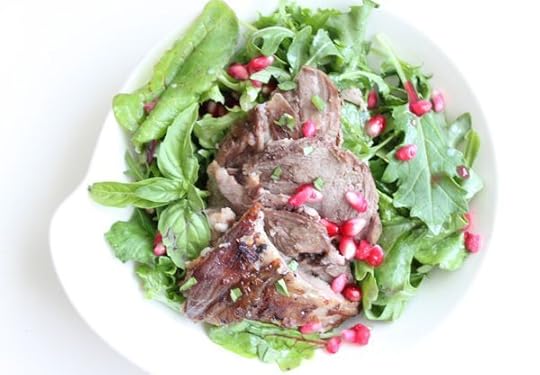 If you haven’t eaten lamb in a while, here are a few good reasons to head to the butcher shop: lamb is a complete protein, it’s high in iron, and a rich source of conjugated linoleic acid (CLA). Another reason not to forget about lamb is that a recipe like this one – Lamb and Pomegranate Salad – just isn’t the same with beef, pork or chicken.
If you haven’t eaten lamb in a while, here are a few good reasons to head to the butcher shop: lamb is a complete protein, it’s high in iron, and a rich source of conjugated linoleic acid (CLA). Another reason not to forget about lamb is that a recipe like this one – Lamb and Pomegranate Salad – just isn’t the same with beef, pork or chicken.
Lamb shoulder is marinated in garlic, ginger and a hint of cinnamon then slow-cooked until tender. Instead of salad dressing, the greens are tossed with the warm jus left in the roasting pan, topped with slices of succulent lamb and garnished with sweet-tart pomegranate seeds and fresh basil. The pomegranate and basil add bursts of flavor and color to the rich meat.
While other cuts of lamb can quickly go from perfectly pink and tender to tough and chewy, you don’t have to keep a close eye on lamb shoulder. Lamb shoulder is a confidence-building cut that’s almost certain to come out juicy, tender and flavorful even if you only season with salt and pepper. Allow a few hours for roasting in the oven and you’ll be rewarded with a hearty and deeply flavorful roast that requires very little hands-on cooking time.
Lamb and Pomegranate Salad looks so gourmet, you’ll be surprised by how easy it is to make. Throw together a quick marinade, let the meat soak up the flavor, then put the meat in the oven and let it be. A few hours later you’ll have a succulent cut of meat and a salad like no other.
Servings: 3-4
Ingredients:
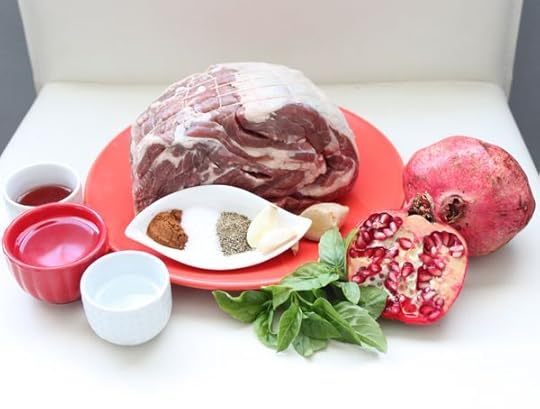
2-3 pounds lamb shoulder (900-1350 g)
4 garlic cloves, finely chopped
2-inch piece of peeled ginger root, sliced thinly
1/2 teaspoon cinnamon (2.5 ml)
1 teaspoon kosher salt (5 ml)
1/2 teaspoon black pepper (2.5 ml)
3 tablespoons coconut oil (45 ml)
3 tablespoons red wine vinegar (45 ml)
1/4 cup water, plus more if needed (60 ml)
1-2 pomegranates
Large handful of fresh basil, roughly chopped
Greens for the salad (try arugula, mache or mixed baby greens)
Instructions:
You can whisk together the marinade, but using a blender combines the flavors better. In a blender, combine the garlic, ginger, cinnamon, salt, pepper, coconut oil and vinegar. Blend at medium or high speed until garlic and ginger are finely chopped and the consistency is like a runny paste.
If the lamb is held together with netting, take the netting off and unroll the meat. Rub the entire roast down with the marinade.
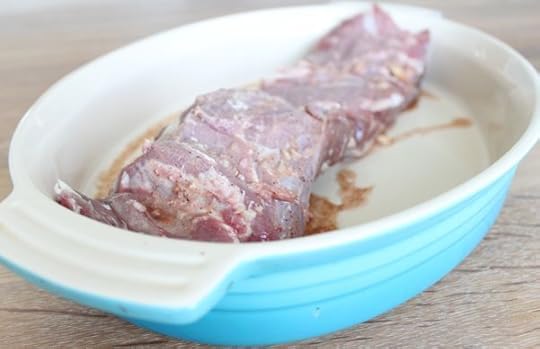
Roll the roast back up and put the netting back on to hold it together. Let the meat sit at room temperature for 1 hour to marinate, or refrigerate for several hours.
Preheat oven to 325 °F (163 °C)
Place the lamb in a roasting pan, fat side up, and add the water.
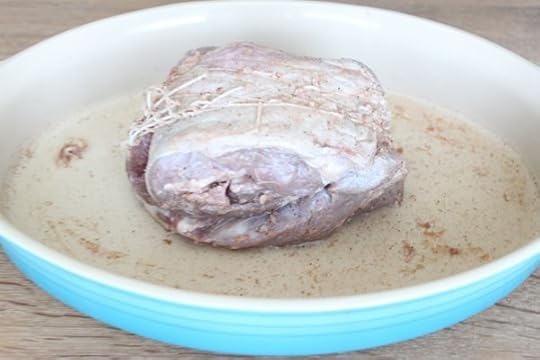
Cover tightly with foil (or a lid) and roast for 2 to 2 1/2 hours, or until the meat is very tender and pulls apart easily with a fork. As the meat roasts, check it once or twice to make sure the pan is not dry. This will only happen if the foil isn’t tight enough and steam escapes. If for some reason the pan is dry, add another 1/4 cup of water.
When the lamb has finished roasting, take off the foil and turn on the oven broiler to low. Broil the lamb just to crisp up the strip of fat on top, 3 to 5 minutes.
Remove the lamb from the oven and transfer to a cutting board. Let it cool enough that you can touch it, then slice or shred the meat.

Cut the pomegranate in half. Squeeze out the juice into a bowl. You can drizzle a little juice on the salad if you like, or just drink it straight. Whacking the skin side of the cut pomegranate repeatedly with a spoon will make most of the seeds drop out into a bowl; the rest you can scrape or pick out.

To make each salad, put 2 large handfuls of greens in a bowl. Drizzle 3 tablespoons of the warm pan drippings onto the greens and toss. Arrange meat on top. Sprinkle with pomegranate seeds and garnish liberally with basil.

Get the Primal Blueprint Fitness eBook, Free Health Tips and Primal Recipes Delivered to Your Inbox

October 5, 2012
Primal Persistence: Staying the Course Through Life’s Ups and Downs
It’s Friday, everyone! And that means another Primal Blueprint Real Life Story from a Mark’s Daily Apple reader. If you have your own success story and would like to share it with me and the Mark’s Daily Apple community please contact me here. I’ll continue to publish these each Friday as long as they keep coming in. Thank you for reading!
 Hi, I’m Rio. I’m 29 years old and I’ve been Primal since October 2011. I’d like to say that since then I’ve lost 25 kgs (55 lbs) and have a visible 6-pack. However, that for me is not the case. My story is still successful, but it is more a story of persistence.
Hi, I’m Rio. I’m 29 years old and I’ve been Primal since October 2011. I’d like to say that since then I’ve lost 25 kgs (55 lbs) and have a visible 6-pack. However, that for me is not the case. My story is still successful, but it is more a story of persistence.
I’ll start with the usual. I’ve been overweight my whole life even though I was an active child/teenager/young adult. Mum used to put “healthy” food on the table with a few treats on the weekend, but I was still painted with the “big girl” label. Unfortunately, the healthy food consisted of bread, pasta, potatoes and grain-based snacks. I started Weight Watchers when I was 12 years old. I was 72 kilos (158 lbs). Since then I feel like my life has been a perpetual cycle of “feeling naughty” and depriving myself. I have tried the weird and wacky diets (such as the soup diet) and more depressingly the CW “eat healthy and exercise” diet. I worked my butt off at the gym, ate low fat, and calorie-counted to within an inch of my life, and still I never saw the numbers I hoped for. I gave up time and time again, only getting heavier at the end of every attempt. I felt like a failure. At the end of 2010 I was 87 kgs (191 lbs) (I’m only 156 cm (5′ 1″)) and felt huge. I was also due to get married in April 2011. I always thought that my wedding would be the time when I would finally lose the weight and I thought up until now that my early attempts hadn’t worked because I didn’t have the ultimate motivation. I so wanted to be a thin and beautiful bride, so I hopped on the “eat right and exercise wagon” again, and again I was disappointed and devastated…I was, after all my efforts, going to be a chubby bride. My wedding was a wonderful day, because I married the love of my life, but I’ll always look back with a tinge of regret over my size.
 In August 2011 after returning from our honeymoon and ballooning yet again to 87-88 kgs (191 to 193 lbs) and feeling miserable and fat, I thought to try a different approach and booked in for 12 Hypoxi sessions which were incredibly expensive (around $700 for 12 sessions). Hypoxi treatments consist of cycling gently for 30 minutes with your lower body encased in a pressurised chamber which applies and releases pressure as you cycle. The theory is that the pressure mobilises your body fat into the blood stream, so that you can magically cycle it away. Far fetched? Kinda. The Hypoxi team set you up with a list of suggested foods to “eat and not eat” which consisted of eating good fresh food and avoiding refined carbs and potatoes 2 hours after a Hypoxi session. I thought I’d better follow the eating plan since I was paying so much money for the treatments. Surprisingly, I lost a good chunk of weight and centimeters around my body and looking back it was really my first introduction into the Primal lifestyle – low carb and gentle exercise (compared to the approaching-chronic-cardio exercise regime I was used to). Not convinced it was the Hypoxi treatments that caused the weight loss on its own, I started to research low-carb diets when someone posted a link to Mark’s Daily Apple to a Facebook page I am a member of. Once I started reading the articles and information on your site I was instantly hooked. I downloaded The Primal Blueprint and devoured it in a few days. I started eating Primal and my energy levels improved instantly…I couldn’t believe it! I’d gone from being tired and listless all day (falling asleep on the couch around 8 pm every night) to bounding out of bed in the morning and not feeling tired until 10 pm that night, with none of lethargy through the day (which I had started to think was “normal”). With little effort I lost 5 kilos (11 lbs). I felt great!
In August 2011 after returning from our honeymoon and ballooning yet again to 87-88 kgs (191 to 193 lbs) and feeling miserable and fat, I thought to try a different approach and booked in for 12 Hypoxi sessions which were incredibly expensive (around $700 for 12 sessions). Hypoxi treatments consist of cycling gently for 30 minutes with your lower body encased in a pressurised chamber which applies and releases pressure as you cycle. The theory is that the pressure mobilises your body fat into the blood stream, so that you can magically cycle it away. Far fetched? Kinda. The Hypoxi team set you up with a list of suggested foods to “eat and not eat” which consisted of eating good fresh food and avoiding refined carbs and potatoes 2 hours after a Hypoxi session. I thought I’d better follow the eating plan since I was paying so much money for the treatments. Surprisingly, I lost a good chunk of weight and centimeters around my body and looking back it was really my first introduction into the Primal lifestyle – low carb and gentle exercise (compared to the approaching-chronic-cardio exercise regime I was used to). Not convinced it was the Hypoxi treatments that caused the weight loss on its own, I started to research low-carb diets when someone posted a link to Mark’s Daily Apple to a Facebook page I am a member of. Once I started reading the articles and information on your site I was instantly hooked. I downloaded The Primal Blueprint and devoured it in a few days. I started eating Primal and my energy levels improved instantly…I couldn’t believe it! I’d gone from being tired and listless all day (falling asleep on the couch around 8 pm every night) to bounding out of bed in the morning and not feeling tired until 10 pm that night, with none of lethargy through the day (which I had started to think was “normal”). With little effort I lost 5 kilos (11 lbs). I felt great!

Since those initial 5 kilos the weight loss has been slow, but still on the decline. I’ve lost about 15 kgs (33 lbs) and 17 cm (7 inches) from my waist since my initial Hypoxi session. My measurements are also still decreasing. What is more amazing is that the shape of my body is changing. I’ve lost 10 kgs (22 lbs) before on the “eat healthy and exercise regime,” and sure I got smaller, but my body shape didn’t change all that much. This time my waist is visually smaller, nipped in at the sides, arms, and legs.
However, three or four months ago I had a “Primal stumble.” For some reason (winter perhaps?) my sugar and carb cravings came back. I got depressed and I got “angry.” Oh my, was I angry…..at life, at my husband and at my stupid body for not responding the way I wanted it too (why hadn’t I lost all my weight?!).
After the 5th serious fight with my husband (which seemingly seemed to start over nothing) I knew something had to change. I knew that the actions and attitude that I was portraying was just NOT me! So after doing some research on how I was feeling, two weeks ago I did two things. I started CrossFit (my exercise had dropped to nothing during winter), and I gave up the birth control pill. I am now 14 days no hormones, and I am finally starting to feel like myself again. I can’t begin to describe the effects giving it up has already had on my mind, my emotions, and my libido. As for CrossFit…I love it! It has the structure I need, with the freedom to work within and push through my own limits and boundaries.
I often felt frustrated reading other people’s success stories, and think, “why did I not lose 20 kilos in the first 6 months and get ripped abs?” But then I have to stop and think what I’ve gained. I’ve gained health. I’ve gained energy like I never could have imagined. I’ve gained my happiness back. And I’ve gained a healthy body that bends and twists and lifts and runs.
If I were to offer any tips to the Groks and Grokettes out there like me, it would be to keep going. This thing is for life. It’s not a quick fix and not many people (outside the community) get that – I can’t count the amount of times people have said to me “what do you think will happen when you go back to eating normal.” Well, I am eating normally, thank you very much.
Another thing that helps me stay sane is having a fantastic support network around me. My husband Scott is sometimes-but-not-100%-Primal, but very supportive. I have a fantastic friend/personal trainer who is passionate about Primal/paleo nutrition and lifestyle, and a great friend who is also living the Primal life and lifting heavy stuff. It is beneficial to have people to bounce ideas off of, to ask for advice about what worked for them when this or that happened, and to generally glow in the awesomeness which is the Primal lifestyle. What is even better is that I’ve now managed to convince my mum and my sister to adopt the Primal principles. I’m so happy that they too are now on the track to being healthy and happy.
So in the end, being Primal for me so far is not about what I’ve lost….rather what I’ve gained (health, energy, an inner glow). And I couldn’t be happier.
Rehanna

Grab The Primal Blueprint Cookbook Today and Receive Free S&H and a Free Primal Blueprint Poster

October 4, 2012
How to Cultivate Resilience, or What It Takes to Keep on Keeping on
 It’s the utter resolve I’ve seen in a training client who lost his legs in an accident and now runs marathons with the use of prosthetics. It’s the friend who lives with a medical condition that imposes debilitating pain and continues to run a successful business, raises a tight-knit family, and volunteers in his community. It’s any of us who pick ourselves up after a profound loss or life transition, who decide exceptionally challenging circumstances aren’t going to keep us from leading fulfilling, grateful lives. I’m also mindful of those who may have struggled through the recent 21-Day Challenge, but don’t want to give up just days after it has ended. If that’s you, listen up.
It’s the utter resolve I’ve seen in a training client who lost his legs in an accident and now runs marathons with the use of prosthetics. It’s the friend who lives with a medical condition that imposes debilitating pain and continues to run a successful business, raises a tight-knit family, and volunteers in his community. It’s any of us who pick ourselves up after a profound loss or life transition, who decide exceptionally challenging circumstances aren’t going to keep us from leading fulfilling, grateful lives. I’m also mindful of those who may have struggled through the recent 21-Day Challenge, but don’t want to give up just days after it has ended. If that’s you, listen up.
Resilience can encompass the emotional and physical stamina to get through a patch of rough weeks or bounce back from illness or injury. Even more dramatically, however, resilience can mean the fortitude to deal – and even grow – with life-changing setbacks.
There’s no romanticization here. Resilience isn’t a superhero trait. We talk of “conquering” limitations, beating back disease, overcoming loss. The reality is much more complex. Those friends and clients who have been amazing models of resilience have also been fully, richly human. Not every day is a good day. Not every step leads you forward. Not every battle is won. We all pick ourselves up at some point, and some days we let ourselves stay “down” a little longer than others. We feel what we need to feel. The pivotal point is recovering yourself and reengaging your life on renewed terms.
Psychologists have examined the phenomenon of resilience as a varying characteristic among people. Some people, when faced with hardship seem buoyed by a sense of perspective and energy. They are more likely to get back on the horse while others struggle more intensely. Resilience appears to be a trait influenced by our individual brains themselves – our molecular mechanisms that process stress to be more precise.
More so, however, it’s a mindset that can be cultivated, a flexibility in engaging the rough and tumble of life as well as a willingness to live with ambiguity. It’s perhaps also an art we can undertake, a richness we can weave into the support and substance of our lives. The more resilient we are, research shows, the more satisfaction we tend to garner from life.
The Primal question is how can we cultivate resilience in ourselves? How can we design a life that encourages optimum thriving – and supports us most when life challenges us head on.
Exercise
Good solid health with all the basics in line will do you right every time. Sleep, diet, and movement all matter as much if not more when it comes to building resiliency. Some interesting research highlights the role of exercise, however. A whole host of research highlights the stress, depression, and anxiety busting (and buffering) effects of exercise. When compared with rest, for example, a 30-minute block of moderate exercise was better at decreasing anxiety as measured by subjects’ responses to photographs, including stress provoking images.
Research does seem to suggest, however, that this buffering becomes more than an immediate dose response, so to speak, but a persisting pattern over time. Regular exercise produces a continuing psychobiological impact that overhauls our stress response itself. Over time, exercise contributes to our overall mental resilience.
Mindfulness
In the midst of major life challenges, we can at turns benefit from the richness of nostalgia and envisioning future prospects. Also important, however, is the capacity to be purely in the moment, to release expectations, questions, and plans. Mindfulness, in addition to eliciting the body’s relaxation response, can play a key role in acceptance, a crucial process for living with challenging circumstances.
We often expend a lot of energy and anguish pushing back against difficult changes when we’d be better served shifting gears and realigning our paths in light of new realities. Likewise, it can take an immense patience to “sit with” a feeling – physical and/or emotional. To be sure, there are things that people unnecessarily, even irresponsibly, accept when they have the opportunity to change them. There’s a difference, I think, between conscious acceptance and expedient resignation. If you talk to survivors of significant trauma or serious health crises, I think they’d tell you acceptance isn’t by any stretch a passive endeavor. It’s a dynamic, growing, and ongoing process. True mindfulness attends to this process.
For different people, mindfulness can take different forms. Some may practice yoga, Tai Chi, or other programs. Others might pray or immerse themselves in other meaningful ritual. Still others might seek peace simply by spending time in the wild, letting their involuntary attention take over and letting go of everything but their awareness of the world in front of them. All, I think, would say they’re taking comfort in releasing themselves to something larger than themselves and their struggles.
Social Connection
Research has long affirmed the importance of social connectedness to well-being. A close (not necessarily large) social network is, in fact, one of the major contributors to life satisfaction and a protective factor that contributes to resilience.
We all know how good it can feel to lean on those who we know when times get tough. A solid support system can be there to provide emotional and logistical help when times get tough, but close friends and family can also make a difference in how we handle the challenge of normal life transitions. The well known longitudinal Grant study revealed that close friendships were among the most key influences on how subjects adapted to life in their later years. Overall, our close social connections can dampen the stress of our experiences by giving us a critical outlet for the myriad of emotions life evokes and providing perspective when we see them go through struggles of their own.
Play
Children use play to experiment with the wide variety of feelings, experiences, and ideas they encounter in their development. Experts use play therapy to help children process trauma, transition, and other difficult events. Across lifespan and experience, play builds connections and cultivates behavioral, intellectual, and emotional flexibility. Our species maintains the capacity for play throughout our many years and for good reason. As a result of play – the experimentation, exploration, and creativity it fosters – we can continually adapt to different circumstances. When we expand ourselves beyond the daily practice of efficiency and specialization, we can see life – and ourselves – with new eyes. Play, in short, makes us intellectually and emotionally hardier.
In adults, play can mean everything from competitive sport to creative endeavor. Following the death of her husband, a friend of mine took up all manner of handiwork. She did woodworking, carving, and chair weaving. In her words, the crafts took her mind away from her grief and gave her a sense that there were new journeys to be taken. Another family friend took up painting again when she was going through a painful divorce. Another wrote to work through the emotional difficulties he experienced when his child was seriously ill. Play, however we conceive of it, can be an experimental space and emotional sanctuary.
None of us know what the full story of our lives will look like in the end. Amidst (hopefully) a lot of joy, there will undoubtedly be travails. Some problems fall in our laps. Others we create for ourselves. Regardless of their source, we’ll struggle at times – against illness, against failure, against change, against loss. I’d venture to say that many of us have already navigated some kind of critical transition or hardship in our lives.
In our ancestors’ day, calamity was likely more imminent. Grok and his clan, by necessity, weren’t as consumed by the smaller stressors of life, but death and danger loomed in a way we aren’t used to in modern times. What supported our physical survival and resiliency then – social connectedness, intellectual creativity, mental flexibility, and emotional balance – serves our psychological resiliency today.
Resiliency isn’t a fixed capacity. Nor is it an indefinitely standing reserve. We continually create and recreate our resilience by investing in our engagement with life and others. Our daily practices and connections over time deepen our resilience. What helps us thrive in the now grants us fortitude for the long – and difficult – hauls ahead.
I hope you’ll share your own thoughts on resilience. What does it mean for you and your experience? What have you learned about in the course of life and wellness? What stress and adversity have you been able to cope with and bounce back from? Share your thoughts, so that others may follow suit. Thanks for reading today, everyone.
Get the Primal Blueprint Fitness eBook, Free Health Tips and Primal Recipes Delivered to Your Inbox

October 3, 2012
Is Organic a Scam? – Fetal and Child Development and Antibiotic Resistance
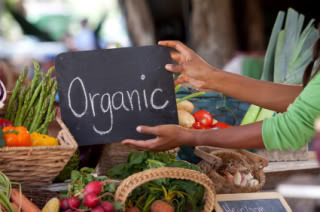 A few weeks ago in Weekend Link Love, I mentioned the great big much-ballyhooed study that appeared to show organic produce was no more healthy than conventional produce. Many people with an axe to grind championed its findings, with some proclaiming the undeniable ringing of the final death knell of organic farming. Science Based Medicine wasted no time in weighing in on the current state of organic food, which they said “represents the triumph of marketing over scientific reality.” Strong words, words that seem to be – at first glance – supported by the study in question. But are they? Are you falling for marketing hype when you buy organic? Is it worth it?
A few weeks ago in Weekend Link Love, I mentioned the great big much-ballyhooed study that appeared to show organic produce was no more healthy than conventional produce. Many people with an axe to grind championed its findings, with some proclaiming the undeniable ringing of the final death knell of organic farming. Science Based Medicine wasted no time in weighing in on the current state of organic food, which they said “represents the triumph of marketing over scientific reality.” Strong words, words that seem to be – at first glance – supported by the study in question. But are they? Are you falling for marketing hype when you buy organic? Is it worth it?
Today, I’m going to discuss the impact of organic and conventional food on two aspects of wellness: fetal health and development and antibiotic resistance. I’ll follow this post up with more articles in coming weeks on the differences between organic and conventional food, and give my opinions on their impact on your health so that you can make an informed decision for yourself. Consider this Part 1 in a series.
Fetal Health and Development
It may be that humans are able to withstand chronic, low-level pesticide exposure without any glaringly negative health effects arising. Heck, maybe the occasional shot of organophosphate pesticide provides a hormetic, net-beneficial effect (I wouldn’t bet on it)! But what about the kids, the tots, the fetuses, the embryos? Might it be possible that what bounces off the thick manly hide of a fully-developed adult human with nary a flick of the eye could throw a wrench in the gears of fetal development? Perhaps the unabashed skeptic who instead of rinsing pesticides off his peach with water rinses water off his peach with pesticides can get away with it, while the pregnant woman craving peaches and Greek yogurt would be better off going organic. I suspect it might.
Earlier this year, a guy named David Bellinger also suspected it might, and so he looked at several studies which examined the relationship between prenatal exposure to organophosphate pesticides (in addition to other environmental pollutants) and cognitive development:
In one study, a ten-fold increase in DAP urine metabolites of pregnant women (the more organophosphates you take in, the more DAP urine metabolites you produce) meant a 4.25 point loss in IQ of their children.
Another study found that the same increase was associated with a loss of 1.39 points.
And in 2007, researchers found that “prenatal levels of organophosphate pesticide metabolites are associated with anomalies in primitive reflexes [in the children], which are a critical marker of neurologic integrity.”
Bellinger didn’t cover them all, though. There’s considerable evidence that chlorpyrifos, a pesticide often used on apple crops, causes brain abnormalities – thinning in some areas, enlargements in others – in children with significant prenatal exposure. Fetal organophosphate exposure has also been linked to ADHD (especially in boys).
Of course, these studies can’t establish causality, and it would be unethical and highly illegal to conduct controlled trials in which pregnant mothers were dosed with pesticides and fungicides to see how their offspring were affected, but we can look at animal studies to get an idea. Although the results are a bit mixed, this review (PDF) generally concludes that the older studies on organophosphate pesticides found them to be “safe,” while the more recent animal studies find evidence of mutagenic and teratogenic effects, particularly on the fetus.
So, does eating organic food reduce exposure to these organophosphates? After all, detractors love to tell us how organic farmers still use organic pesticides – a fair point. That said, as told in a 2006 Pediatrics study, an organic diet significantly reduces a child’s exposure to organophosphate pesticides as measured by the same DAP urine metabolites mentioned in the studies above. In fact, after just a few days of the organic diet, children in the study had virtually eliminated traces of urine metabolites. A 2008 study by the same author reached the same conclusions: switching to an organic diet can drastically reduce pesticide metabolites in kids.
It seems pretty cut and dry to me. DAP urine metabolites correlate strongly with deficits in cognitive development. In controlled studies using animal models, dosing rodents with organophosphate pesticides impairs fetal development. In controlled studies using human children, organic diets essentially eliminate DAP urine metabolites. Is there a smoking gun? No, I suppose not, but I do detect the distinct odor of burnt gunpowder. What about you?
Antibiotic Resistance
As I mentioned in a post from last year, microbes are living, evolving things; when antibiotics are employed to get rid of them, they’ll often develop antibiotic resistance by two primary methods. First, basic natural selection: those microbes that can survive the antibiotic will reproduce, thereby passing on their fitter genes. And then there’s antibiotic resistance by horizontal gene transfer: once a microbe has gained resistance to an antibiotic, the gene that codes for that resistance can be horizontally transferred to other species of microbes. To get rid of the new and improved microbes, novel antibiotics – and more of them – will be administered, but even if this works, the microbes eventually become resistant to the new stuff, too, and the escalation of the situation continues.
Unless you’re talking about organic. Organic livestock never receive antibiotics (if they do, they must be shipped off to slaughter as conventional food, or sold to a conventional producer), whereas conventional farming often employs antibiotics to stimulate weight gain in otherwise healthy livestock. A recent study found antibiotic-resistant bacteria on half of US grocery store beef, chicken, pork, and turkey that were conventionally-raised. And in 2011, a study found that pigs fed antibiotics soon developed a drastically altered intestinal microbiota that converted feed into energy more efficiently (it made them fatter), had a greater proportion of resident E. coli, and showed evidence of increased antibiotic resistance – even to antibiotics that were never administered! Meanwhile, organic meat shows up with far less antibiotic-resistant bacteria, and one recent study even showed that converting a conventional poultry farm into an organic poultry farm began reversing antibiotic resistance within a single year.
Now, it’s true that as long as you cook your meat well and avoid ground meat that you don’t trust (well-done steaks and no more hamburgers – sounds great, doesn’t it?), you probably don’t have to worry about any personal, immediate health risks from consuming conventional meat contaminated with antibiotic-resistant bacteria. But what about the long game? What about the fact that otherwise harmless bacteria who’ve learned to resist antibiotics might pass their knowledge onto virulent bacteria? What about the fact that many officials are calling drug-resistant bacteria the next major global health threat?
I hope I’ve given you some (organic) food for thought. For now, ruminate on this post, but don’t make any rash decisions. Don’t freak out, no matter how scary the data might seem. Next week, I’ll explore the widely held claim that organic produce is no more nutritious than conventional produce to see if it holds up.
Take care, folks. Thanks for reading.
Get the Primal Blueprint Fitness eBook, Free Health Tips and Primal Recipes Delivered to Your Inbox

Mark Sisson's Blog
- Mark Sisson's profile
- 199 followers



